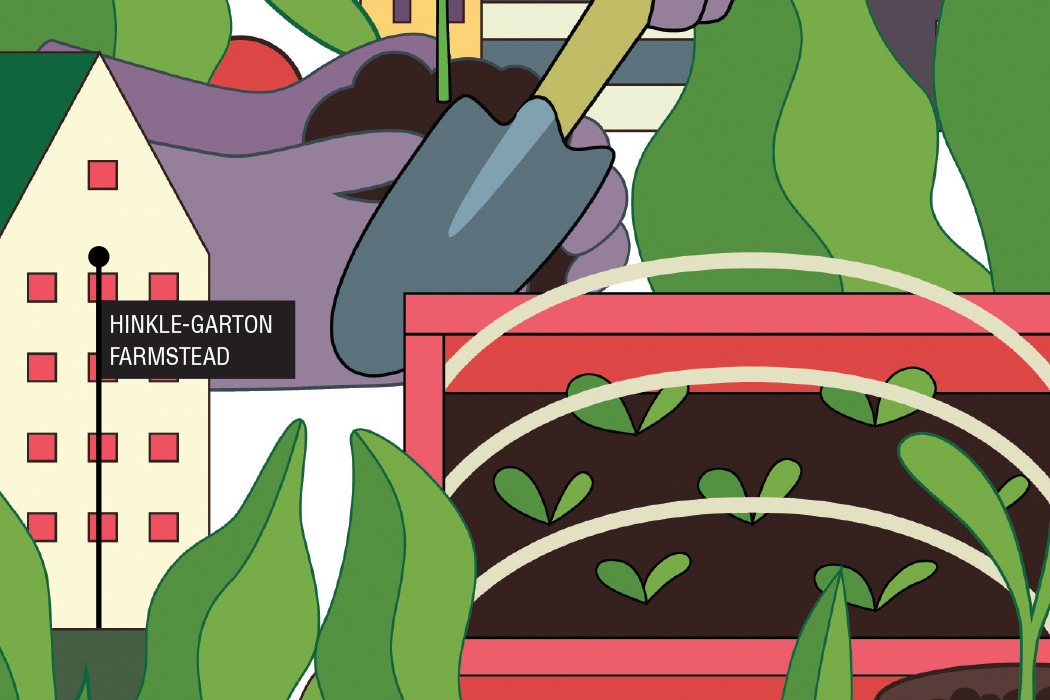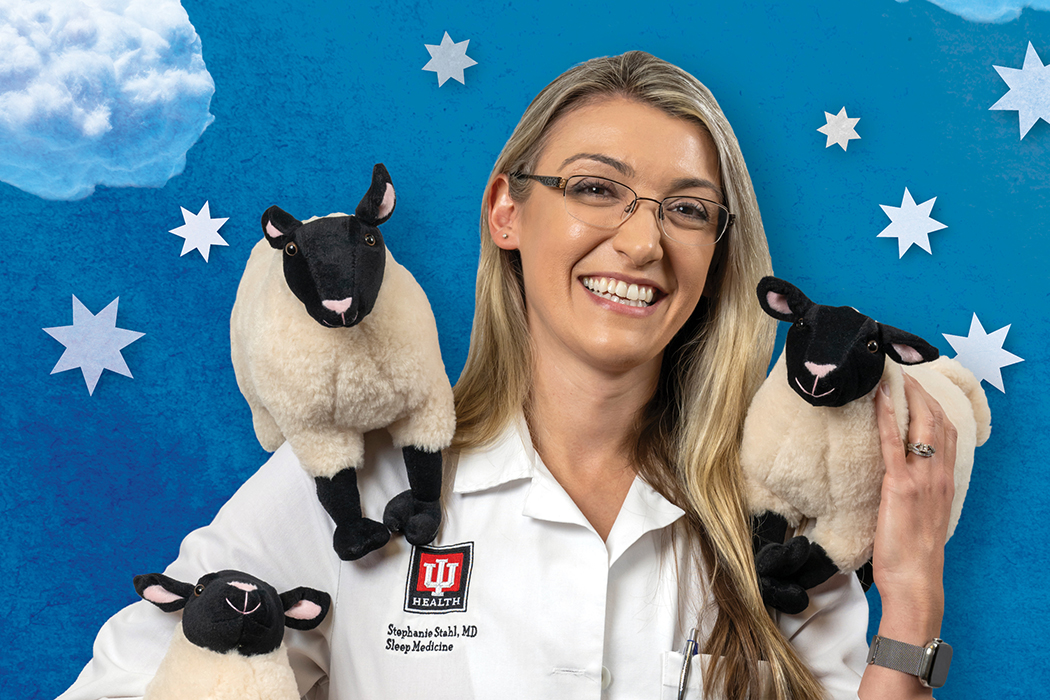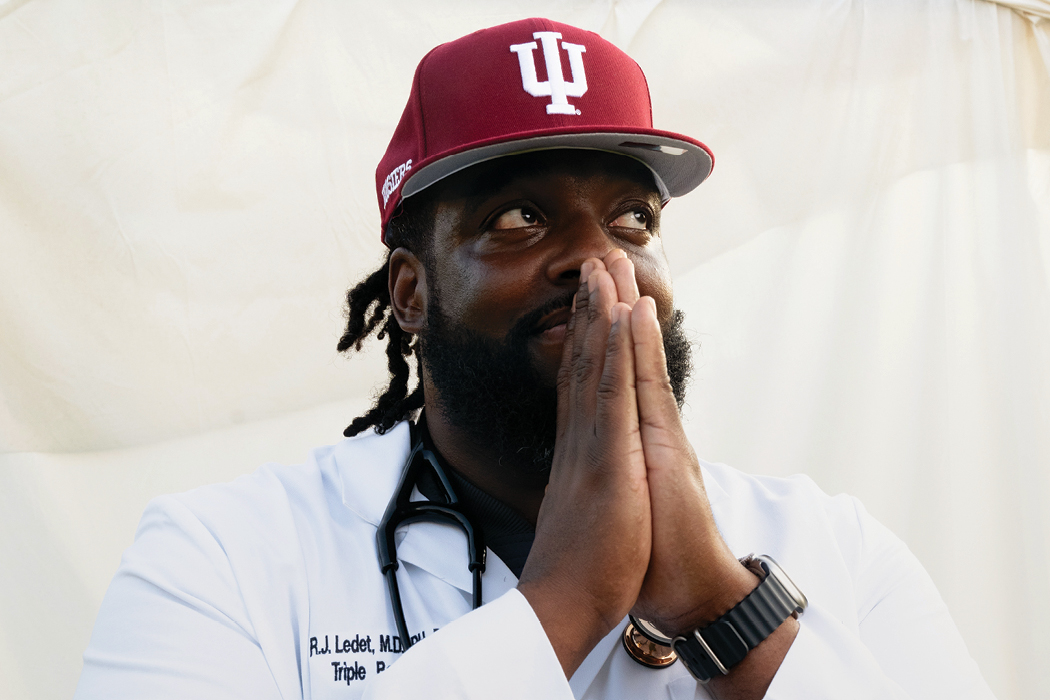A Field, a Farm, and a Food-Sourcing Feat

Take 10th Street east out of Bloomington, past the bypass, and to your right, tucked into a pocket of apartment complexes, you’ll find the future of urban farming nestled in IU’s backyard.
In years past, you might have mistaken the Hinkle-Garton Farmstead—its Queen Anne-style 1892 farmhouse and four aging barns built on 10 mostly fallow acres—as just another piece of the Indiana landscape. But this year—and if all goes according to plan, for decades to come—passersby will know this plot as the IU Campus Farm.
They will know it by its flourishing crops, bustling student and research activity, and the contributions it makes to the Bloomington community’s sustainable food supply. Hopefully, those passersby will also become active farm participants, such as volunteer planters or chaperones for their children’s classroom visits.
The IU Campus Farm’s mission is to promote sustainable food systems education through food production, research, creative activity, service, and outreach to the campus, community, and beyond. But before the farm’s vision can be realized and its harvest of benefits reaped, there are seeds to be sown, and much work to be done.
Breaking ground—and fixing America’s broken food system
In 2010, the U.S. Department of Agriculture reported that 23.5 percent of Americans live in a food desert, meaning that they live more than one mile from a supermarket in urban or suburban areas, and more than 10 miles from a supermarket in rural areas. In addition, American eating habits have become increasingly less sustainable, as our diets are the most resource intensive in the world to produce, and we waste more than 40 percent of our food.
We could devote the remainder of this story to listing similarly dour facts, all pointing toward the same conclusion: America has a food problem, much of it related to the system by which we receive our food.
“We have a complex food system that isn’t working for many,” says Dr. James Farmer, associate professor in the School of Public and Environmental Affairs and co-director of the IU Campus Farm. “We produce a lot of food, but much of it is unhealthy to people and harmful to the environment. To make matters worse, our climate is changing, and we need to rebuild food systems in a sustainable fashion, ensuring that all people have access to a healthy, just, equitable, and environmentally sound food supply.”
It was this set of complex and pressing food challenges that drove Farmer and his colleagues to apply for a grant from the campus’s newly created Sustainability Innovation Fund that would help launch the IU Campus Farm. They then reached out to Bloomington Restorations, a local nonprofit dedicated to preserving historic architecture in Monroe County, and came to an agreement that would locate the farm at the 10-acre Hinkle-Garton Farmstead on East 10th Street.
And in October 2017, ground was broken at that location in preparation for the farm’s inaugural planting in spring 2018.
Farm to (dining hall) table

Although only a portion of the acreage dedicated to crop production was ready to be cultivated in the farm’s first year, the spring 2018 planting still yielded a wide array of organic produce, from spinach and kale to tomatoes and peppers—mostly served up to the IU campus and local emergency food system.
Indeed, the vision for the crops grown on the farm is that they will be used to provide sustainable, healthy food options to several outlets on campus, including the Indiana Memorial Union, Residential Programs and Services, and Dining Services. In addition, 10 percent of the farm’s produce is being donated into the emergency food relief system in the Monroe County area. Soon, food will be going to the Crimson Cupboard food pantry, a student organization on the Bloomington campus that provides free food to food-insecure students and others facing financial hardship.
“Institutions like IU are massive, and everyone on campus has to eat,” says Jacob Mills, an environmental and sustainability studies major, and current Campus Farm intern. “Why not provide as much as we’re able to from within the university itself?”
Beyond providing students with fresh, healthy food, the Campus Farm also enables IU to source more of its food locally, reducing the environmental resources (and associated costs) needed to transport, cool, and store food from more distant locations. Shortening the supply chain also helps reduce food waste and loss.
These resource savings—and the fresh food for campus—may be the most obvious, immediate benefits of the farm. However, its long-term impact promises to be even greater: teaching students and community members about urban agriculture, and enabling them to build a more sustainable food system from the ground up.
A 10-acre classroom
In just its first year, the farm has already offered a wide range of experiential learning opportunities for IU students: Kelley School of Business students have helped with marketing efforts; SPEA students have learned about soil building and regenerative agriculture; and students from a Geography of Food course have used the farm to study the effects of invasive species.
“Agriculture is one field that encompasses many different disciplines,” Farmer notes. “The farm is a piece of infrastructure that will serve a broad swath of the campus community.”
Students have also gained hands-on experience (literally) by readying the soil for planting and by working as farmhands. Jacob Mills helped plant lettuce, tomatoes, beans, cucumbers, and kale, and has assisted with the raising of the farm’s two high tunnels—covered structures that allow the farm to grow crops year-round.
Mills sought out the physical labor of planting as a means of putting into practice the concepts he’d explored in his environmental and sustainability studies courses.
“Because I’ve learned about some of the negative effects of conventional agricultural methods, I think it’s extremely important to learn how to grow food organically,” he says.

What the farm needs to thrive
Thanks to the grant from the Sustainability Innovation Fund—as well as a partnership with Hilltop Garden and Nature Center (an IU-affiliated organization that has provided greenhouse space for the farm’s starting seeds), and generous donors who helped purchase the first two high tunnels—the IU Campus Farm has been able to get its first round of crops and research projects off the ground. But there is so much more that can be done.
From purchasing necessary equipment, to building and renovating infrastructure, to funding a full-time farm manager and a cohort of student interns, the farm has a long list of immediate needs.
“Right now, we’re making wise use of our resources,” Farmer notes, “working with a used tractor, a part-time farm manager, and piecing together funding for student workers from a variety of sources. But with additional support, we could do quite a bit more.”
Lea Woodard, coordinator of Hilltop Garden and co-director of the Campus Farm, agrees.
“If we rely just on produce sales, we’ll be able to maintain basic operations. But donors allow us to grow: to achieve our goals faster and with more confidence—to reach beyond a small-scale farm to really create change and inspire the next generation.”
Beyond the farm: urban plots and finding common ground
The long-term vision for the farm includes cultivating a fruit-tree orchard and a three-acre pasture for livestock. Eventually, Farmer would like to expand operations beyond the Hinkle-Garton Farmstead and into Bloomington proper.
“We want the farm to showcase what you can do in an urban context, but Hinkle-Garton is bigger than most urban farms,” Farmer points out. “Once we fill out that property, our long-term goal is to identify and gain access to satellite sites around town to mimic the urban production system on a smaller scale in various places.”
Farmer, Woodard, and their colleagues are playing an active role in mending America’s broken food system—and they believe that the time is right for a food revolution.
“The coolest thing about what we’re doing here is that sustainable food systems are a place of common ground,” Farmer says. “Republicans and Democrats, young and old: they all have an interest in food—in what they and their kids are putting into their bodies. What I love about the work that we’re doing here is that it’s important for everyone.”
Join the food revolution by supporting the IU Campus Farm today. Please use the button below to make a gift to the IU Campus Farm Fund, or contact James Farmer at jafarmer@iu.edu or 812-856-0969 to learn more about how you can help.
This article was originally published in the fall 2018 issue of Imagine magazine.
Tags from the story
Written By
Ryan Millbern




